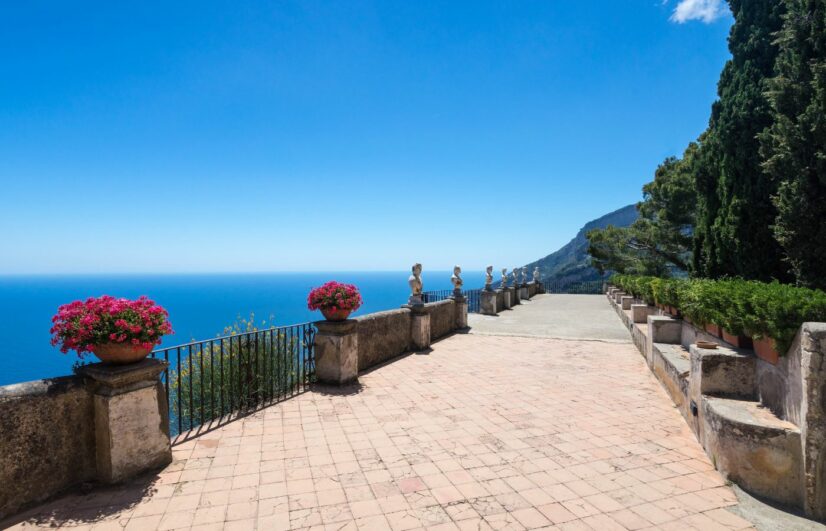Villa Cimbrone is one of those places you must visit if you come to the Amalfi Coast. Situated on a promontory not far from the centre of town, this historic residence resembles a daydream: among lush gardens, statues, ornaments and breathtaking views, through a crescendo of amazement, it leads you to one of the most beautiful terraces in the world.
Prepare to daydream, because in this article we will guide you to the discovery of Villa Cimbrone, one of the most evocative and magical places on the Amalfi Coast.
Indice dei contenuti
What you will see at Villa Cimbrone
You will be impressed right from the entrance, when you walk down Viale dell’Immenso and walk under a roof of blue and white wisteria. Immediately after the ticket office, you will admire the cloister, with its obvious Siculo-Norman elements,
Then you will encounter the crypt, Lord Grimthorpe’s creation, with its sacred and profane elements: in this courtyard, restored between 1907 and 1911, the Bloomsbury circle met, which elected the villa as a literary club.
Continuing on, you will admire the Mercury hillock, with its bronze statue representing a copy of the Resting Mercury from the school of Lysippus.
Next, the small temple of Bacchus, of classical inspiration, supported by eight fluted columns, in Doric style. In the centre of the temple, on a pedestal, a dancing satyr holds up Bacchus with the inevitable bunch of grapes.
Continuing the walk, among scented flowerbeds adorned with flowers, statues, decorative elements and terracotta vases, you will reach the splendid Terrace of Infinity, adorned with statues: here you will be suspended between the sky and the sea, 365 metres above sea level, and with a bit of imagination, you will really have the sensation of flying.
From the Terrazza dell’Infinito the view embraces the entire Amalfi Coast, as far as the Cilento mountains and the Paestum plain.
This place is so beautiful and romantic that it is often chosen as a location for wedding proposals.
Other moments of amazement, during your walk, you will experience by admiring:
- the Terrace of Roses;
- the Statue of David, which stands in the middle of the wood and was created by the sculptor Gioacchino Varlese;
- the Grotto of Eve, the work of Adamo Todolini;
- the Tea Room, consisting of four columns from the Roman era and some beautiful sculptures.
How to get to Villa Cimbrone
Compared to the more famous Villa Rufolo, which overlooks Piazza Duomo, Villa Cimbrone is a little more hidden. From the square in Ravello, proceed along Via Santissima Trinità, then proceed towards Via San Francesco and finally turn into Via Santa Chiara.
The walk takes no more than ten minutes and allows you to enjoy the tranquillity and beauty of Ravello’s quiet alleys.
If you are travelling by bus, from Salerno you can reach Amalfi first, either on board the SITA buses or by taking advantage of Travelmar’s sea services, generally operating from April to mid-November. From Amalfi, wait for your bus to Ravello. You can purchase tickets from authorised retailers (tobacconists, bars or newsagents), which generally display the UNICO badge. Alternatively, you can use the UNICO App to purchase your tickets directly from your smartphone.
If travelling by car, from Salerno proceed along the State Road 163 Amalfitana, as far as the Castiglione junction, about two kilometres from Amalfi. From here, proceed to Ravello.
The town of Ravello is not characterised by the huge tourist flows that storm other destinations such as Positano or Amalfi: here you will not find droves of travellers and tourists, but quiet, elegant streets that invite you to walk and enjoy a quiet day. For this reason, even finding a parking space will not be difficult.
If you would like more information on how to get around the Amalfi Coast during your stay, we recommend downloading our free guide “How to get around the Amalfi Coast without stress”. Inside, we have collected all the useful and indispensable information you need to make your move from town to town easier.
Curiosities about Villa Cimbrone
In addition to the prestigious Bloomsbury circle, Winston Curchill, the author E.M Forster, and the famous economist Maynard Keynes D.H. Lawrence, the author of Lady Chatterley’s Lover, also visited and loved Villa Cimbrone.
Greta Garbo fled from here in February 1938 with the intention of marrying Leopold Stowkowski.
The history of Villa Cimbrone
The name of the historic building derives from ‘Cimbronium’, the hill on which it stands. A castle, which today corresponds to the Convent of Santa Chiara, and a lookout point once stood in this area. Everything else consisted of a farmhouse that belonged to a number of influential families in Ravello’s history, including the Acconciagioco family from 1300, the Fusco family and the d’Angiò family from 1500.
The recent discovery of a tombstone dating back to 1620 suggests that the major renovation and maintenance work on the building was carried out by the Fusco family, probably with the intention of transforming what was once agricultural land into something more in line with the Renaissance taste of the time.
For several centuries, this splendid residence, surrounded by lush, fertile nature, remained abandoned.
Until one day an illustrious English gentleman came to Ravello to soothe a severe depression caused by the loss of his wife: he was William Beckett, a distinguished English historian.
It was the period between the end of the 19th century and the beginning of the 20th century: the Amalfi Coast and Ravello were not yet the crowded tourist destinations we know today, but mostly intellectuals, artists and writers travelling on the Grand Tour came here, falling madly in love with these places, with the gentle climate and dreamy atmospheres they found there.
This was also the case for William Beckett, known as Sir Grimthorpe, who fell in love with Villa Cimbrone and in 1904 bought part of it with the intention of restoring new splendour to those places.
If our dandy, in love with romanticism, did not turn the purchased building into a cold Art Nouveau villa, it was thanks to the mediation of Nicola Mansi, a local who had emigrated to London and convinced Baron Grimthorpe to rely on local labour instead of the skill of a professional architect.
It may seem a curious anecdote to crack a smile, but the current romantic charm of Villa Cimbrone derives precisely from the use of local labour, perhaps naturally imbued with Mediterranean essence. And perhaps also from the happiness of Nicola Mansi who, as the son of a construction worker, must have thought he had rediscovered his father’s roots by undertaking the renovation of the villa.
The renovations lasted for about 15 years and gave rise to the eclecticism that we can still admire today inside this amazing place.
Villa Cimbrone, in fact, is not striking for its architectural rigour or coherence, but for an irresistible mixture of styles, inspirations and architectural citations, creating a romantic, Mediterranean, dreamlike atmosphere.
After the Second World War, as the Villa was British property, it was confiscated by the state and remained in a state of neglect for about ten years, until it was bought by the Vuilleumier family, who took charge of restoring it to its former splendour in the 1960s.
Today Villa Cimbrone houses a luxury hotel, but its gardens are open to the public and can be visited every day until sunset.





